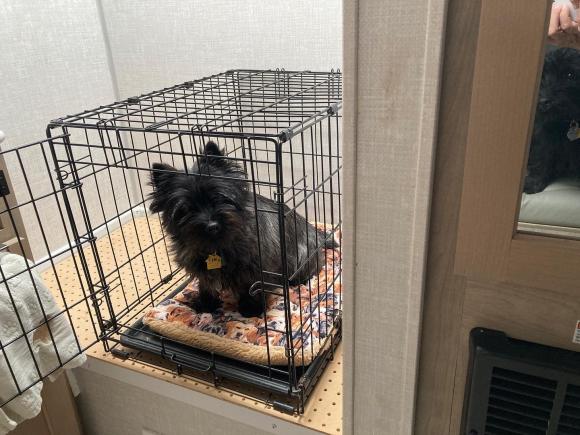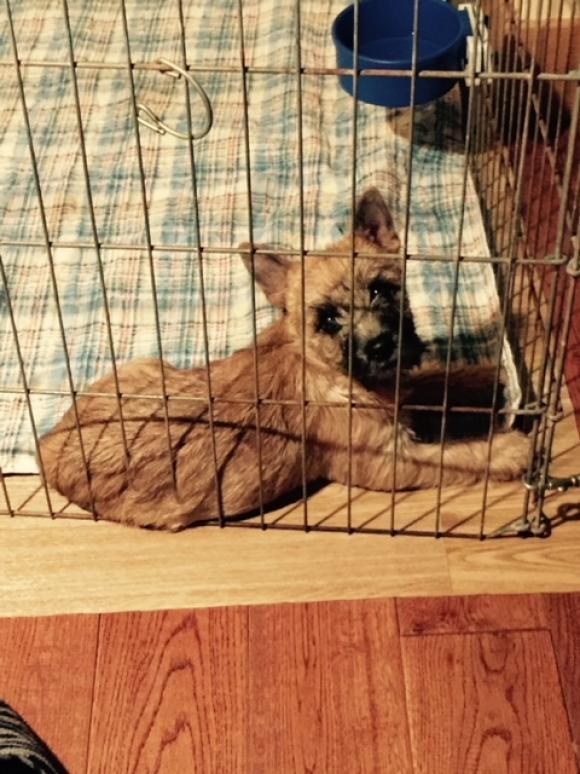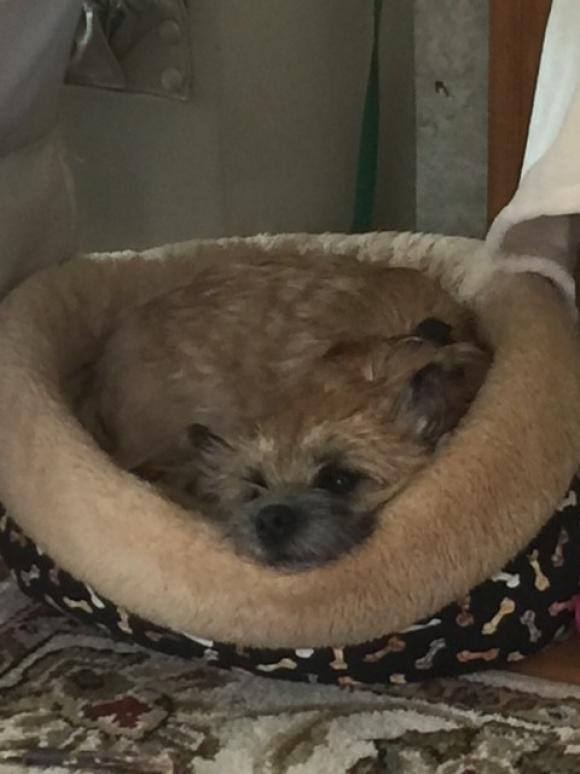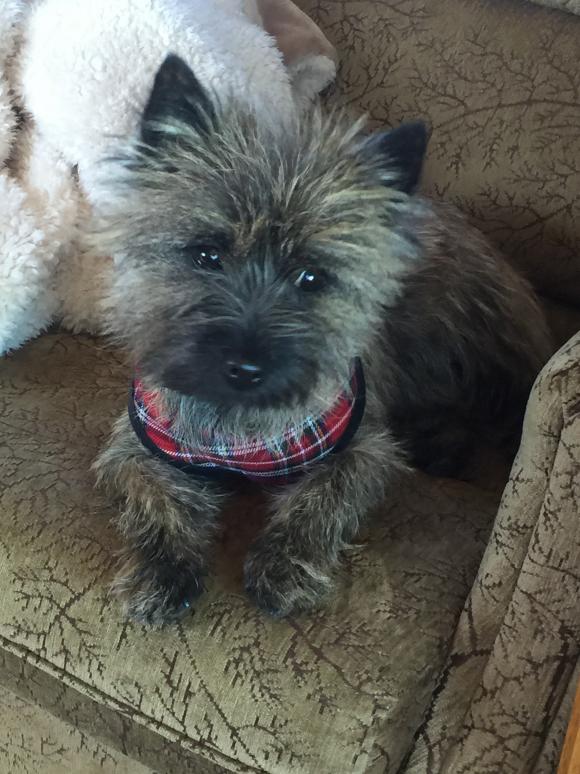Suggested Equipment
Here are some items you should consider having on hand for your new puppy!

It's an exciting day--you are finally bringing your new Cairn puppy home from the breeder. Are you prepared? Here's a suggested list of what you might need:
CRATE: A size 200 or medium crate with a secure locking door. Whether it's plastic or wire, you need a crate your Cairn will fit in after full grown. Consider a crate that is easy to clean. Purchase a crate that you can block off the back portion with a box or divider. Why? If the crate is too big for the little pup, he may decide to use a portion for this bathroom, and you don't want that. Nor do you want to purchase multiple crates as the pup grows. That is why blocking off the back of the crate with a box or divider is a good idea until the pup is full grown. Then just remove the box or divider! If you choose a wire crate, you can always cover the back with a towel or blanket. Just make sure fresh air can enter the crate so your pup can breathe.
EXERCISE PEN WITH POTTY PAD OR LITTER BOX, DOG BED, WATER BOWL, LINOLEUM: Cairns are very social and LOVE their people. Having a safe place in the family area where the pup can be with the family, yet safely contained, is important. An exercise pen (X-pen or ex-pen) works well for this purpose. You can set it up in an area where the pup can see everyone and be part of the action without being underfoot or engaging in potentially dangerous or destructive behavior while unsupervised (and young puppies should be safely in their ex-pen or crate when not being directly supervised!)
Make sure you have a bowl for clean water that attaches to the grating of the pen and not on the floor! A hanging water bottle with a stem or nozzle the puppy licks works well for this. If you put a bowl of water on the floor, the pup will step in it and potentially knock it over many times a day. Also, if you don't want the floor messed under the X-pen, here's a tip from breeders. Purchase a remnant of linoleumat a home improvement or flooring store that is larger than the X-pen and put it under the X-pen. If the edges of the linoleum are rolling up, simply tape them down using heavy duty double-sided tape for carpeting (providing the tape will not harm your flooring). Also provide a crate or soft bed in the X-pen (dogs love beds with sides, just make sure you can wash the bed), a litter box or potty pad in a potty pad holder, and safe toys. When potty training your puppy, some breeders prefer using puppy litter and a litter box. Others prefer the potty pads in a potty pad holder.

Ask your breeder what she used to begin training the pup and continue that method since the pup is used to it. Please note that some puppies love to kick the litter everywhere and if you have floor vents, expect to be digging the litter out of the vents. A clever breeder trick is to purchase a large plastic tub with lid that the potty box will fit in. Then cut an opening on one of the narrower ends of the box that the pup can enter. Place the litter box with litter inside the cover of the larger plastic box (like the kind you store holiday ornaments in) and place the rest of the box on top of the cover. Be sure to sand the opening smooth so your puppy will not be injured when going inside to do his business. You have now made an inexpensive litter box house and it helps keep the litter from going everywhere!
Another breeder tip is to place the potty litter box or pee pads at the back of the X-pen, away from where the pup will run when you enter the room. If you place the potty box or pads at the front of the pen, the pup may step in his poo when he runs to greet you. We don’t want that!
HANGING WATER BOWLS (Two bowls--one for crate and one for exercise pen) Your puppy should always have access to clean, fresh water. A water bowl that attaches to the door of the crate will ensure your puppy has access to water when confined. You can get these at any pet store or order them online. Hint: for ease of filling the water bowl while the pup is in the crate, a plastic watering can with a long, slim nozzle works well! You can get the watering can at any garden center if you don't already have one. Just make sure it is clean and disinfected if you have used it for something else before. An alternative to a bowl is a water bottle with a nozzle that is licked to access water, with a stainless-steel licking stem. Choose a top filling container for easy filling with clean water. It's also easier to wash and clean as well.


Cushy Dog Beds. A comfy, cushy dog bed(s) is a must! Dogs especially love cushy beds with sides on them, also known as bolsters. They also love the fabric cubes (sometimes these cubes are also sold as cat beds). Choose beds that are washable. Beds in various rooms of the house will often be used by dogs!
Safe Toys and Chewies. Many chewies sold for dogs such as rawhide can cause choking or intestinal blockages if swallowed. A choking pup can die very quickly. Check with your vet for advice on safe chewy products. Additionally, many toys (and pieces of toys) can cause choking or intestinal blockages if swallowed (the squeakers inside stuffed toys are a common problem if swallowed). If your Cairn swallows a squeaker, surgery may be required and the pup might not survive the experience. So you must supervise your pup with any toys that can be ripped apart. Your pup might like to chase a tennis ball or a hard rubber ball. Just check the ball regularly to make sure it is in good shape and he or she is not pulling off the fabric coating or chewing up the rubber and swallowing it.

Leash, Collar, Harness, ID Tags, (and microchip if not provided by the breeder). It should go without saying that you need a collar, leash or harness for your pup. If you purchase a collar or harness in a store, try it on your puppy to make sure it fits. If you buy a collar or harness online, measure your puppy’s neck to identify which size to purchase. Also get a leash (note: most leash laws specific that no leash be longer than six feet long—check out the laws in your area). Please consider purchasing a retractable leash with utmost caution. They can wrap around your legs or your dog and result in severe injuries if your dog is being pursued and attacked by another animal. A harness avoids pulling on your pup’s delicate neck and choking him. Make sure you get ID tags also-one for the collar and one for the harness. Some recommend not putting your dog’s name on the tag in case someone who finds or steals your dog tries to claim the dog was theirs. Instead, consider an alternative such as “Microchipped”, “Help Me Home”, or “Reward” on the tags. Include your phone numbers, City and State, and if room, your Vet’s phone number.
FOOD: Your breeder will send you home with a supply of the pup's food and suggest quality brands of dog food. You will be feeding your pup 3 times a day, then reduce the feeding at the age your vet tells you. There are many good websites where you can learn about different brands of quality dog food, such as Whole Dog Journal which regularly publishes a robust review of most dog foods. Please note that recently there have been safety issues with some dog food and treats made in China. The US Food and Drug Administration (FDA) regulates dog food and publishes information about recalls and other safety information.
OTHER HELPFUL ACCESSORIES: If you let your pup run around the house, he will have accidents outside of his pen. So you need to be prepared to clean the mess. If you have a cleaning mop, you can clean up pee with a mopping pad, then spray the floor with a pet stain cleaner, then mop that up with a clean mopping pad. If you don't like clogging the environment with mopping pads, an absorbent towel or microfiber cloth can be used to cover the head of the mop and held on with thick elastic bands. Then you just need to wash the towel or microfiber cloth.
CLEANING CHEMICALS: Please read labels carefully, do your research, and clean with safe products. Some cleaning chemicals are poisonous to pets! If you use bleach diluted with water, you must rinse thoroughly with clean water. Bleach is toxic to pets and people if ingested. There are many non-toxic cleaners. Read labels carefully. To help get rid of the odor of pet stains so the pup does not repeatedly use the same spot to "do his business" pet accident odor removers can be helpful, though, you may find that nothing completely gets rid of the odor hidden in carpet padding or the grout between tiles.
LANDSCAPE HAZARDS. Avoid those green, gorgeous lawns. Perfect green lawns, and less than perfect lawns, may have been sprayed with toxic chemicals. When your dog walks on these lawns, he gets the chemicals on his feet and brings them home. Later, if the pup licks his feet, he is ingesting potentially toxic substances. The incidents of cancer in dogs has increased, and research suggests landscaping and cleaning chemicals, may contribute to these trends. Be aware these substances might be present on your neighbors’ front yards, public parks, etc.
Take Training Classes As Soon As Possible! Puppy socialization and training classes are critical to the development of your puppy and their long-term behavior. Many dogs end up in shelters due to behavioral issues. Unfortunately, a breeder who has not provided adequate socialization for their puppies and/or the owner is often to blame for this. Research training classes that use positive reinforcement methods in your area on the Internet before you get your puppy. Ask others who have taken their dogs to training classes about what they liked and disliked. Once you find potential training classes, consider asking if you can observe a class before you get your puppy. Avoid trainers and classes that use force, coercion, harsh verbal or physical corrections, punishment, dominance, and similar techniques. These techniques not only can erode the trust and relationship between you and your puppy, but can result in long-term behavior problems such as fear-based biting and aggression. The American Veterinary Society of Animal Behavior has several position statements on these topics (see below). And if you enjoy working with your puppy, don’t stop at the puppy manners class! Continue to reinforce good behaviors and learn new ones. There are many resources for dog training online (including YouTube) as well as through American Kennel Club (AKC) dog clubs and private training schools. The AKC offers a Canine Good Citizenship Program and certificate (see below), and if you really enjoy training, consider one of the many AKC dog sports (see below)
Final Words. Adding a dog to your family is like having a child. It is a family member for LIFE. If you don’t have time or resources to walk, feed, groom, train, spend time with, play with and care for a pet—don’t get one! Pets are not disposable and feel abandonment very deeply, and the hurt lasts a lifetime. There is NO excuse for discarding a pet—none. If you obtained your Cairn from a reputable breeder, give the dog back to the breeder. DO NOT take it to a shelter, give it away, or dump it on the side of the road. Imagine if your parents did any of these to you. A reputable breeder should take the dog back and place it in an appropriate home, but if for some reason this is not the case, contact a Cairn Terrier rescue group or AKC Cairn Terrier Club for assistance.

This information is for educational purposes only. It does not reflect the official endorsement of the Cairn Terrier Club of America. It identifies the suggestions and helpful hints of many long-time breeders. You do NOT need all this equipment. These are recommendations only.